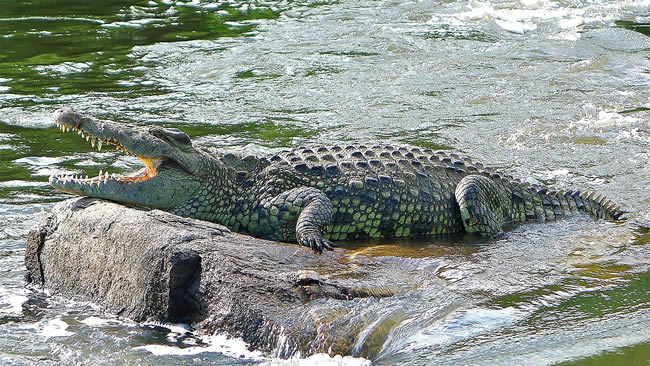This national park was established in 1993. However, before it became a national park it was initially a Forest Reserve. It’s majorly known for hosting one of the greatest concentrations of bird species in East Africa. But the national park has mammals in equal amounts too. It is also true that Semliki National Park was initially a sunken area in a lake millions of years ago.
This accounts for why the park areas flood especially during rainy seasons. There are tribes that live near and within the park include Batwa, Batuku, Bakonzo, and Bamba. This goes to show how the ecosystem in the National Park has for numerous generations supported human livelihoods within and around before and after it was gazetted as a national park.
Semliki sits on the floor of Semuliki Valley and much of its areas are dominated by lowland tropical forests which are an extension of Ituri Forest spanning from eastern D.R Congo. The forest forms part of Africa’s most biodiverse ecosystems and has graced the continent for over 18,000 years. The valley is bundled with many landform features most of which are accounted by the formation of Mt. Rwenzori and the Western arm of East Africa rift valley.
Location of Semliki National Park.
The Park is at the border of Uganda and D.R Congo, bordered by Lake Albert in the North and the great Rwenzori Mountain in southeast. It gently stretches within the Western valley of the East Africa rift. It’s also bordered by rivers Lamia and Semuliki. It is largely a conservation area which is connected to the wider Rwenzori conservation ecosystem.
Attractions in Semliki National Park.
This national park has for more than 25,000 years been a hub of both existing and extinct Wildlife species. There have been shifts and immigration for several of the wildlife species over the years into Congo and the neighboring Rwanda.
The Park has a composition of more than 120 mammal species of all kinds i.e., land mammal species such as forest elephants, antelopes and forest buffalos. There is equally a wide range of primate species including baboons, monkeys, as well as chimpanzees. Semliki National Park is also blessed with aquatic animals such as crocodiles and hippopotamus.

The other fascinating attractions include hundreds of bird species that are hosted by this national park. Bird population here are over 350 species. These include over 23 bird species that are endemic to Albertine rift, lowland birds, and migratory birds from the neighboring countries near this National Park.
Insects also add to the available attractions and these are estimated to be more than 700 insect species within both the Savannah and forested areas of Semliki National Park.
Tourist activities in Semliki National Park.
- Birdwatching.
As noted earlier, there are more than 350 bird species in this National Park and therefore this creates a good ground for the birders to engage in the birding activities. The area around Sempaya hot springs is a main center attraction for birds, and creates one of the best spots to spot birds.
Expect to spot birds such as Brown-crowned Eremomela, Lemon-bellied Crombec, Northern Bearded Scrub Robin, African Dwarf Kingfishers, Chestnut-flanked Goshawk, Ituri Batis, Zenker’s Honeyguides, the White-spotted Flufftail, the Spotted Lyre-tailed Honeyguides, the African Wood Owl that’s known to be accustomed to the night, Yellow-throated Nicator, the African Goshawk, Red-thighed Sparrows, and many more.
- Forest and Nature Walks.
The forest within Semiliki is so unique from many other forests around the country. It has, besides the trees and other green vegetation, numerous insects, birds, and numerous primate species. The first has been made conducive for the nature walks through the construction of trails on which the interested tourists have a good time walking through the forested areas. Trails are mainly three i.e., 11 kilometers Red-monkey trail, 8 kilometers Sempaya trail, and then the 3 kilometer Kirumia hiking trail.
- Game drives.
Game drives are made within the savannah lands and over 50 different species of mammals are visible. The Park has the desired plains which are composed largely of grasslands that give off a proper site and breeding grounds for the mammals. Notable species are elephants, buffaloes, antelopes, etc.
- Chimpanzee tracking.

There are a few chimpanzees habituated within the forest areas. These were habituated by the Indiana University and a permit costs about $50 per person. Besides chimpanzees there are also other primate species such as the black and white colobus monkeys, baboons, red-tailed monkeys, among others.
It is additionally recommended for tourists that would want to engage in chimpanzee tracking to come prepared with comfortable and suitable wear for movements in forested areas that may have potential thorns and inflammatory plants and insects.
- Cultural visits and experiences.
These are mainly around the cultures of the Batwa, Bakonzo, Batuku, and Bamba. They all have unique customs and tourists will find them interesting, especially through their folklore, traditional dances, clothing, residence construction and structures, language, among others.
When to visit?
Typical of the lowland areas within the rift valley regions, this national park has a variation in its dry seasons which start as early as April and go up to September, although having a few intervals of recorded rainfall. These periods are there for the best recommended for touring Semliki National Park. Subsequent rainy seasons provide a challenging experience with mud that visitors have to encounter something that makes navigation complicated.
How to get there?
There are various routes to access this National Park. To begin with, is the route from Uganda’s capital city, Kampala to Fort Portal (passing through the districts of Masaka, Mbarara, and Kasese). This is the longest route and it takes about 7 to 8 hours on road.
The whole distance is estimated at about 463 kilometers. The second available route, is that from Kampala to Fort Portal, through the districts of Mityana and Mubende, covering an estimation of 360 kilometers which takes an average of 5-6 hours on road.
